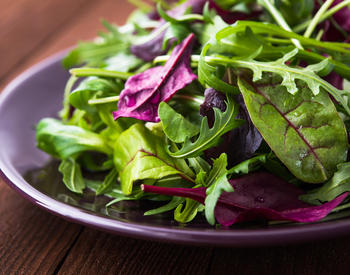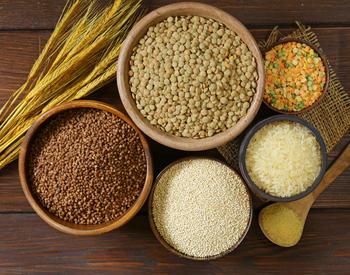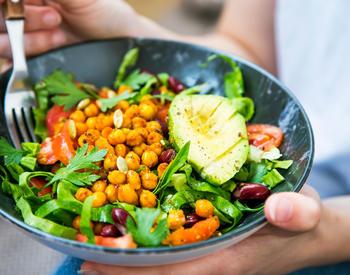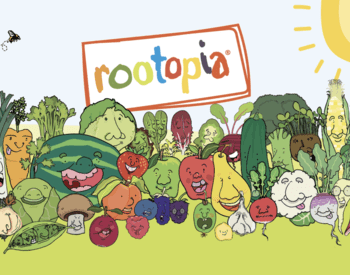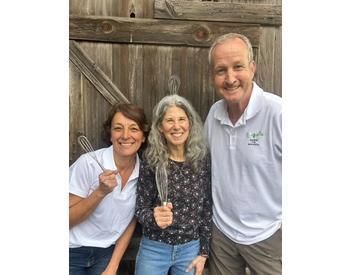Transcript
My name is Kelly Street, and I'm a registered dietitian with the Oregon State Extension Service Family and Community Health Program located in Clackamas County. In this video, we will discuss the Oregon farm direct marketing law and demonstrate how to ferment foods via lacto-fermentation.
So, what is the Oregon farm direct marketing law? The Oregon farm direct marketing law, passed in 2012, allows farmers to produce certain low-risk value-added products such as fruit spreads and pickled and lacto-fermented fruits and vegetables and sell them directly to the consumer without a processing license, as long as they grow the produce themselves. This law provides farmers with an opportunity to generate a supplemental income, add variety to their offerings, use up excess produce, and extend their market season. We have found that farmers need a bit of guidance in implementing the law, including where to find tested recipes and interpreting labeling and record-keeping requirements. That's why OSU Extension is delivering education on the farm direct law through a series of videos and workshops. Information on the law can also be found in the Oregon State University publication "Oregon's Farm Direct Marketing Law: Producer Processed Value-Added Products."
If you plan to produce a product for sale under the farm direct marketing law, you will have to use a tested recipe. A tested recipe has data to support food safety. You will find tested recipes and current food preservation instructions in the USDA Complete Guide to Home Canning, So Easy to Preserve, the University of Georgia National Center for Home Food Preservation, Pacific Northwest Extension Service food preservation publications, as well as other publications from other extension services located throughout the United States. If you want to produce an acidified food, such as a relish or salsa, using your own recipe, you must first submit it to a recognized process authority for approval. This process is outlined in the mentioned OSU publication.
Today, we will prepare a tested recipe for escabeche, which is a lacto-fermented Mexican dish consisting of pickled vegetables, onions, carrots, hot peppers, and garlic. This dish is often served alongside fish entrees and tacos. You will find this recipe in a University of California Cooperative Extension publication titled "Fermentation."
Lacto-fermentation is a process that converts sugars to acids, gases, or alcohol in the absence of oxygen. Lactic acid bacteria break down foods, making them more acidic. Examples of lacto-fermented foods include quick pickles, sauerkraut, hot sauces, kimchi, and pickled vegetables. The lacto-fermentation process can take from 3 to 6 weeks depending on the ambient temperature. The cooler the temperature, the longer the time.
Now, let's make some escabeche. We begin by assembling our equipment. We start with a large food-safe glass or plastic container, a lid that allows the gases to escape, and a weight that keeps the fermenting food submerged. Be sure to wash everything in hot, sudsy water and rinse well before using to prevent the bad bacteria from leeching into your ferments.
Earlier today, we prepped and assembled the following ingredients needed to fill a quart jar of escabeche: we sliced and removed the membranes and seeds from 3 hot peppers, we sliced and peeled 1 pound of carrots on the bias, and sliced 1 medium onion. We bruised three cloves of garlic and measured out a half teaspoon of oregano, 1/4 teaspoon of coriander, a quarter teaspoon of cumin seed, and 1/4 teaspoon of peppercorns.
Next, we toss the vegetables until thoroughly mixed and transfer them and our spices to our quart jar.
Next, we prepare a brine solution consisting of a quarter cup of canning salt mixed with one quart of non-chlorinated, filtered, or bottled water. Do not cut back on the salt, as it may result in an unsafe product.
Now, we're going to add the brine solution to the vegetable mixture and leave an inch or so below the top of the jar. Once we've added the brine solution to our jar, it's important that we keep it submerged over the top of the vegetables. So, to do that, I'm going to insert this weight here, put a little bit of pressure over the top until all the vegetables are submerged, and then I'm going to take this lid, which is called a pickle pipe, which allows any air around the side to escape to ensure good fermentation process, and then I'm just going to attach that with a canning lid. And now, the fermentation process can take place. We will store the escabeche out of direct sunlight at room temperature for four days to two weeks. A longer fermentation time will yield a tangier, more tart and sour taste. We will check it daily and remove any white scum that forms. If it becomes slimy, soft, gross, moldy, or develops a disagreeable odor, we will discard it. Once the fermentation process is complete, the escabeche can be stored in the refrigerator for several months, where it will continue to ferment at a slower rate. When you are ready to label the escabeche, be sure to follow the guidelines that are outlined in the Oregon Farm Direct Marketing Law.
Thanks so much for joining us for an introduction to the Oregon Farm Direct Marketing Law and demonstration on how to safely prepare fermented foods. We hope that you have found it helpful. Thanks for watching and happy fermenting. For more information on the Oregon Farm Direct Marketing Law, you can contact the Oregon State University Extension Service located in Clackamas County, the OSU Extension Service Small Farms Program, or the Oregon Department of Agriculture Food Safety Program.
This video is one of a series of four produced by the Oregon State University Extension Service in Clackamas County that explains the Oregon Farm Direct Marketing Law (OFDML) and illustrates science-based, step-by-step food preservation techniques. In this video we demonstrate how to ferment vegetables for Escabeche (Mexican spicy pickled vegetables). For more information on the OFDML, or food preservation recipes and techniques, you can go to https://extension.oregonstate.edu/catalog/pub/em-9205-oregons-farm-dire… or https://extension.oregonstate.edu/mfp/publications







